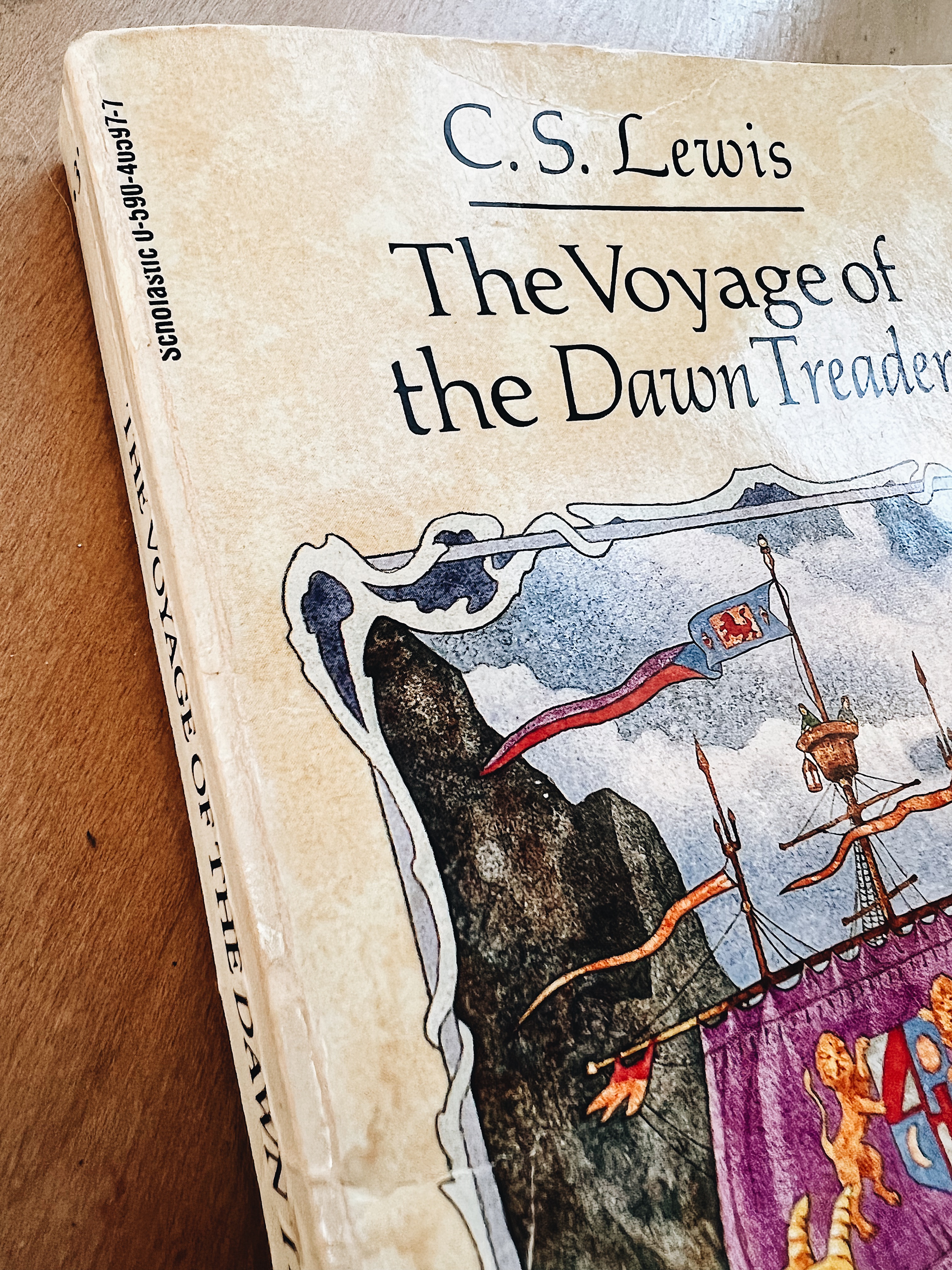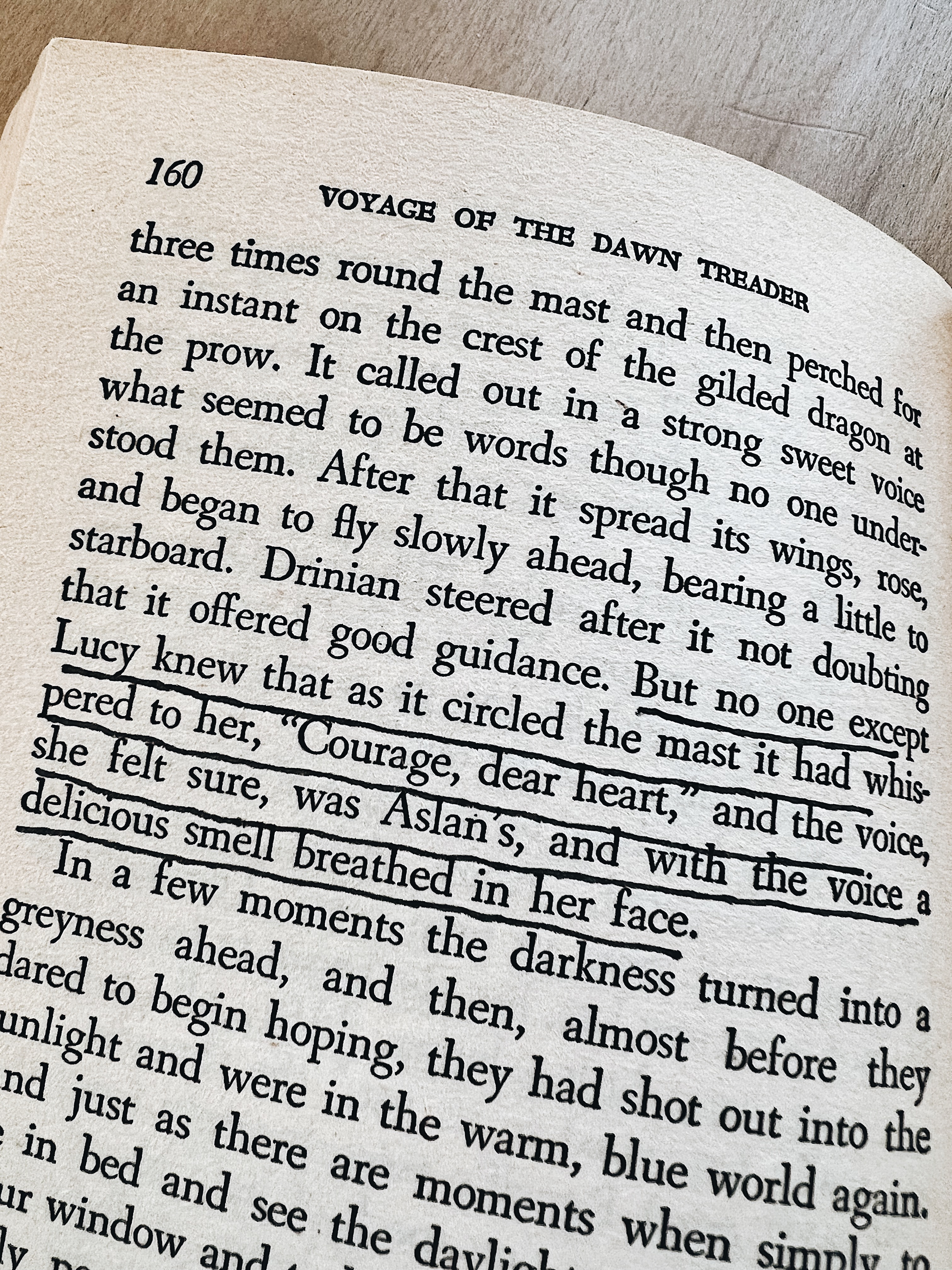The book pages have turned beige, and I don’t remember them starting off beige. They’ve gone beige the way re-run TV shows from the 90s have gone grainy and the hairstyles have poofed and the clothes have bagged. None of this used to be beige, grainy, poofy, or baggy. I swear, when the world was new, the pages were crisp white, the picture crystal clear, and the hair and clothes were stylish, not buffoonish.

But the pages of The Voyage of the Dawn Treader are inarguably beige. My copy came from my elementary school Scholastic book fair. I remember the tissue paper pages of the book fair order form. The “1” marked deeply with pencil next to items I wanted to purchase. The ten dollar bill clutched as my class lined up to snake its way to the library which had transformed overnight with metal shelving and busybody PTA moms taking the bills and handing back books. The pages of The Voyage of the Dawn Treader were white then. Blazingly white, I am positive.
The book is part of the full collection of The Chronicles of Narnia by C.S. Lewis. All seven books in the series came squished in one yellow cardboard box. For years stretching into decades, my books were read and stuffed back in that yellow box. Now, the box is lost or disintegrated, but the seven original books remain. They have cracked spines and battered corners and browning pages. The Lion, The Witch and the Wardrobe has been rebound with packaging tape. I’ve retraced my reading footsteps through these books many times.
At the beginning of The Voyage of the Dawn Treader, Edmund and Lucy, two fortunate adventurers who have previously made visits to the magical land of Narnia, find themselves drawn into that alternate world again. They gaze at a painting, just an ordinary painting of ocean and ship in an aunt’s guest bedroom, but then magic animates the waves in front of their very eyes. What had been dry paint just an instance before becomes saltwater. Edmund and Lucy tip into the painting, splash into the ocean of Narnia, and The Voyage begins.
I do an unaccustomed thing and flip to the very last page in this small yellow book of the Dawn Treader, and I read. Before the adventure begins again in my imagination, page 216 shuts it down. On page 216, Lucy and Edmund land in their real world after Aslan reveals they will never again return to Narnia. They mourn, as I mourn when that final page boots me out of their world. But on page 216, Edmund and Lucy confess to Aslan it’s not Narnia they will miss but Aslan’s presence in Narnia with them. Aslan gives them the greatest reassurance of their maturing lives: he will be with them too, in their own world, answering to a different name. Aslan explains, “You must learn to know me by that name. This was the very reason why you were brought to Narnia, that by knowing me here for a little, you may know me better there.”
I’m not meant to live in the pages of a book. Not the way I lived in books growing up, spending more time with Narnia friends than I did cultivating friendships among my classmates, Girl Scout troop, and softball team. When I look at books on my shelf that are exactly the same and also different from what I remember, I mourn. When did I stop regular visits to these pages? Did Edmund and Lucy ever sit on the bed in their aunt’s guest bedroom and stare at a painting with adult eyes, wishing, daring, hoping, doubting it would turn to water again?
My adult eyes spend less time reading C.S. Lewis’s words and more time writing as I labor alongside him in the career of author. One morning I wake up before dawn to join a virtual writer’s group. The rest of the group is in England. I picture the writers enjoying tea and scones and tepid British morning sunshine. I put on my glasses, pull a sweatshirt over my pajamas, and sit in front of my computer. I have a notebook. My pen. A mug of coffee.
A writing prompt for the session requires I pick up a book and flip at random to a page. I consider the bookshelf at my elbow. I tug out my favorite. The Voyage of The Dawn Treader. I’ve read it a guaranteed seven times but possibly as many as twelve. I land on page 160, allow my eyes to settle on a sentence, and crocodile tears pool behind my glasses. I’ve never read this sentence before, have I?
“But no one except Lucy knew that as it circled the mast it had whispered to her, ‘Courage, dear heart,” and the voice, she felt sure, was Aslan’s, and with the voice a delicious smell breathed in her face.”
This sentence I could only read in the beige page years of life, when I hear Aslan’s voice but know the speaker by a different name.

It’s actually an albatross speaking on page 160 with Aslan’s voice. A bird circles a ship floundering at sea. The bird is a sailor’s delight, having a long enough flight range to bring hope of nearby landfall. C.S. Lewis writes, “It called out in a strong sweet voice what seemed to be words though no one understood them. After that is spread its wings, rose, and began to fly slowly ahead, bearing a little to starboard. Drinian steered after it not doubting that it offered good guidance.”
Courage, dear heart. It’s a direction. It’s not a promise. The words gave enough hope to steer by, at least for that morning, at least for that writing exercise. I hope to revisit page 160 of The Voyage of the Dawn Treader as frequently in adulthood as I did in my youth. I may not fall into the world of Narnia quite the same way I did when I was younger and pages were whiter, but I gather courage. No one else may understand the words, but to me, they whisper, “Courage, dear heart.” That does, indeed, offer good guidance.


Beautiful words for us all–me included. Thank you.